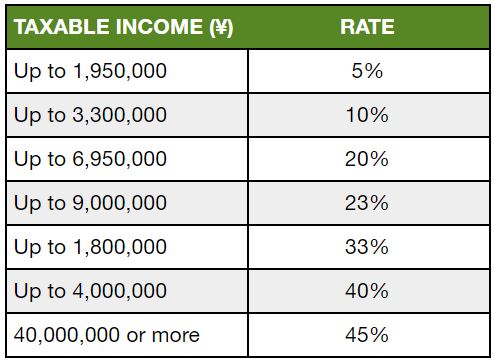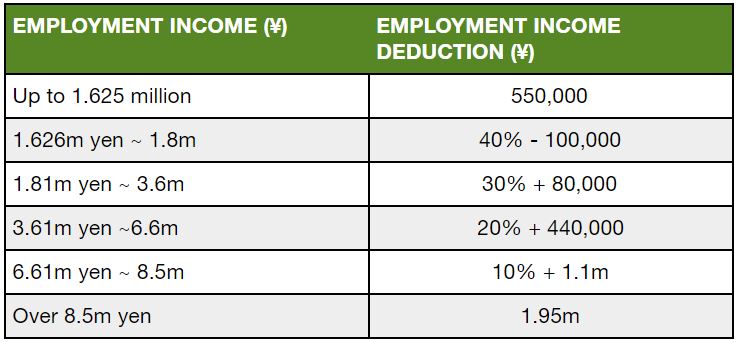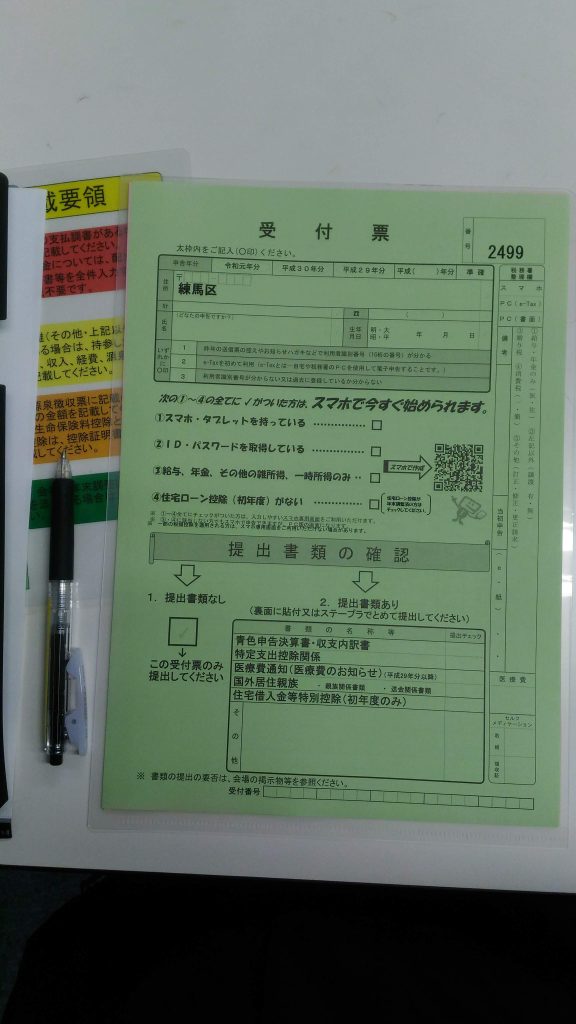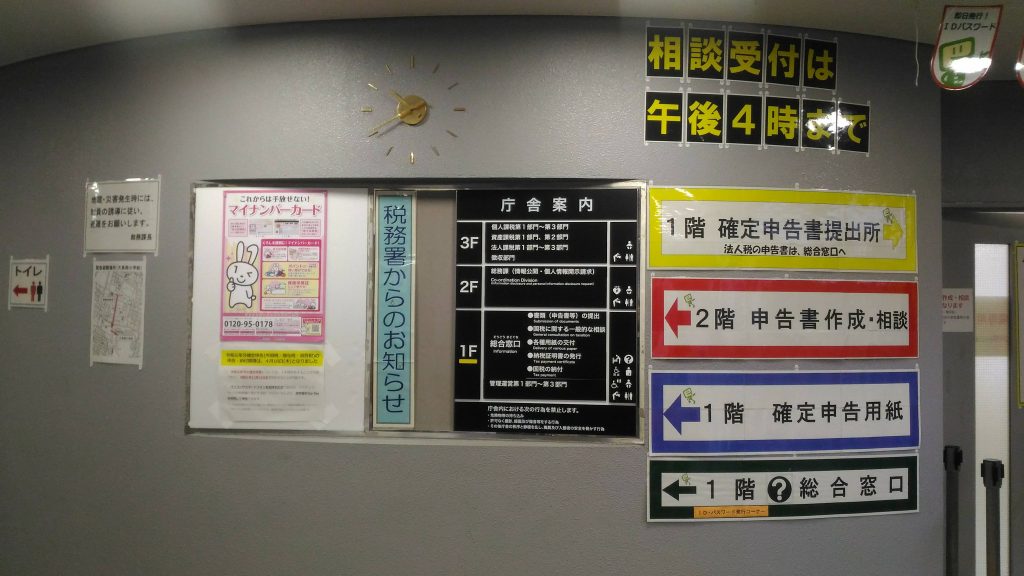
Basic Guide to Filing Taxes in Japan 2020
Tax season in Japan is my yearly headache, what with deciphering kanji on official documents, sorting through my medical receipts, and making multiple trips between home and the tax office because I forgot some required paperwork. This year I finally buckled down and learned the basics about the Japanese tax system and how to arrive at the tax office fully prepared. Hurray! I was able to file my taxes virtually stress-free–I would love to help you do the same!*
*This article contains information synthesized from various online sources and personal experience and is not guaranteed to be error-free, nor is it a substitute for personal research or professional counsel. It does not guarantee any particular results.
How Much Income Tax Do I Owe?
First things first, how much income tax (所得税 shotokuzei) do you owe? This depends on your status of residence. You will fall into one of three categories: permanent resident, non-permanent resident, or non-resident.

- Permanent residents pay income tax on all income, domestic and foreign-earned (全世界所得課税 zensekai shotoku kazei).
- Non-permanent residents pay income tax on all Japanese income and foreign-earned income that is sent to Japan.
- Non-residents pay income tax only on income earned in Japan and do not pay the 10% resident (inhabitant) tax.
How Is Income Tax Calculated?
Japan uses a progressive income tax system. Taxpayers fall into one of seven brackets*.

*Plus an additional 2.1% surtax collected for reconstruction after the Tohoku Earthquake in 2011
If you are a resident in Japan you can claim a personal deduction (¥380,000), spouse deduction (¥380,000), and/or dependents deduction (¥380,000), as well as a range of others. You can also claim an employment income deduction, which is decided by your income bracket and is calculated by a percentage of your income plus a fixed amount.

*Japan External Trade Organization “How to Set Up Business in Japan” Table 3-8 (JETRO source page)
You may also be eligible for a foreign tax credit, depending on your home country’s tax treaty with Japan. (Read TAX TREATY here)
Do I Need to File My Own Income Tax?
If you work for a single employer who withholds your taxes for you, you do not need to file. Instead, you might remember filling out forms regarding your personal information, information about your spouse, and/or the total amount of social insurance premiums (out of pocket). This is part of a year-end assessment (年末調整 nenmatsu chousei) that is finalized in March.
If your company does not withhold income tax, you make over 20 million yen, if you have multiple sources of income, or you make over 200,000 yen through your side job, you must file. (Also, if you leave the country in the middle of the tax year.)
How Do I File Income Tax?
The normal tax deadline is March 15th every year (except when March 15th is a Sunday, in which case the deadline is March 16th). However, this year, because of the Coronavirus, the deadline has been pushed back to Thursday, April 16, 2020.
Tip: in 2020 (Reiwa 2) you will be filing taxes for income earned between January and December 2019 (January of Heisei 31 to December of Reiwa 1, collectively considered Reiwa 1).
While it is possible to E-file, I recommend getting help from the tax office, especially if you struggle with reading the kanji on official documents.

Here’s what you need to take with you:
- original and front-and-back copy of residence card (在留カード zairyu kādo)
- original and front-and-back copy of: Individual Number card (マイナンバーカード) or notification of Individual Number (マイナンバー通知カード)
- personal seal (印鑑 inkan)
- passport
- bank book (通帳 tsuuchi)
- withholding tax certificate(s)* or (源泉徴収票 gensenchoushuuhyou).
*from 2020 you do not need to submit this document, but simply to keep it on file
Depending on your circumstances, additional documents might be necessary. For example:
- To file for a medical expenses exemption (医療費控除), you must bring all your medical statements and receipts*.
- To file for a social insurance premium exemption, you must report the total amount paid out of pocket (each type of insurance)**.
- If you have multiple employers (domestic or foreign), you must report the total amount earned and provide the name and address of one representative company.
- If you have filed in previous years, remember to bring your ID and password.
- If you received a refund the previous year, bring your notification of tax refund bank transfer (国税還付金振込通知書 kokuzei kanpukin furikomi tsuuchisho).
*from 2021, the tax office will not collect medical statements and receipts; instead, you must fill out a medical expenses exemption form (医療費控除の詳細書 iryouhi koujo no shousaisho) or create your own (simply list name of patient, name of the hospital, fees, and a memo for yourself about what the fees were paid for)
**although you do not have to submit your stamped social insurance receipts, you are asked to keep them on file for five years
What To Do At The Tax Office
Armed with all the necessary documents, all you have to do now is go to your local tax office and and find the Help Corner (申告書作成・相談 shinkokusho sakusei soudan).

Tip: arrive early, and double-check you have all the required documents.
Get in line for the help corner, where friendly workers in colored vests will guide you step by step in preparing your documents. Next, they will send you to the Computer Corner, where you can get help entering your information on the computer, printing your tax return, and dropping it in the mailbox.
Done!
What do you think? Is it more or less complicated to file taxes in your home country? Do you have any tips for filing taxes stress-free? And more importantly, how are you going to celebrate having successfully filed your taxes in Japan in 2020?
** Sources **
- Simple English Guide: Tax Guide for Americans
- English Guide – Individual income tax return in Japan 2017-2018
- Bureau of Taxation – official website
- National Taxation Agency – official website
- Ministry of Finance Japan – official website (Learning More About Taxes PDF Booklet- 2019)
- MOFA – General Info
- MOFA – Tax System
- Foreign Residents Documentation
Related Articles
Japanese Restaurant Etiquette: Simple Mistakes That Can Ruin Your Meal
Warning: Undefined array key "sfsi_threadsIcon_order" in /home/veremosglobal/tokyoroomfinder.com/public_html/blog/wp-content/plugins/ultimate-social-media-icons/libs/controllers/sfsi_frontpopUp.php on line 165
Warning: Undefined array key "sfsi_blueskyIcon_order" in /home/veremosglobal/tokyoroomfinder.com/public_html/blog/wp-content/plugins/ultimate-social-media-icons/libs/controllers/sfsi_frontpopUp.php on line 170
Warning: Undefined array key "sfsi_bluesky_display" in /home/veremosglobal/tokyoroomfinder.com/public_html/blog/wp-content/plugins/ultimate-social-media-icons/libs/controllers/sfsi_frontpopUp.php on line 266



